Well our busy season is upon us and we're excited about the plants we're sending. We have several new pond plants this year. A couple new lotus, waterlilies and bog plants. Check them out at our store, www.dragonflyaquatics.com.
I often get questions about whether to use water lettuce or water hyacinths as floaters in the pond. They both basically serve the same purpose.
Water lettuce (Pistia stratiotes) has light green spongy leaves that looked as if they have veins running through them. The leaves are approximately 1-5" wide. The leaves are covered with tiny hairs and occasionally tiny white flowers appear in the center. Water lettuce prefers partial shade during the hotest part of the day and once the water warms up will multiply quickly. Their dangling roots provide a place for fish to hid. Water lettuce can be very aggressive and can deplete the oxygen in the water if you let it take over your entire pond. So its a good idea to take out some if they start to multiply rapidly. Water temperature should be 60 - 65 degrees before placing water lettuce in your pond as it will turn the leaves white and they will die.
Water Hyacinth - Eichornia crassipes) A floating plant that is a fast grower and beneficial for water filtration. They have bright green rounded leaves and will get a purple flower on them throughout the season. Water hyacinth have dangling roots that help filter and clean the water. We have alot of customers who ordered water hyacinths first in the spring to provide shade immediately to help prevent growth of algae. It takes other plants such as water lilies longer to produce their leaves to help provide the coverage needed. When you first receive your water hyacinths you want to put them in shade for a day before adding them to your pond in direct sun or the leaves will turn brown. They need to soak water up in their leaves. Again make sure your water temperatures are 60 - 65 degrees before placing in your pond.
New this year for Dragonfly Aquatics and will be added to our store.
A floating, rootless aquatic fern that floats just below the water surface producing a pair of floating or emergent leaves that are green in color and oblong in shape. They have a third leaf that is brown in color and dangles underwater sometimes mistaken as a root but helps to stabilize the plant. The plant itself has no roots but tiny white hairs beneath the leaves.
HARDY LOTUS
As the lotus leaves begin to turn brown, the lotus is beginning to go dormant for the winter. Do not cut off the leaves; allow them to die back naturally. After they die back at this point, it is safe to cut them off above the water line. Its important to leave a portion of the stem above the water. You do not want water getting down the hollow green stem and having it get into the air channels of the tuber, if this happens you risk drowning the tuber and cause it to rot. Make sure the potted lotus is below the ice. Allowing the tuber to freeze will kill the plant.
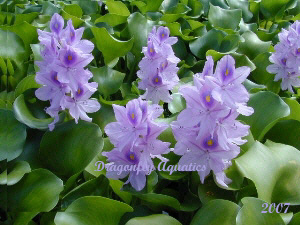
Floating plants such as Water Hyacinth and Water Lettuce are considered tropical and will not survive temperatures below freezing. After the first hard frost, remove from the pond to prevent them from decaying and adding unwanted debris to the pond.
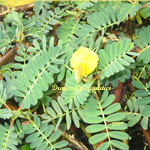 Sensitive Plant (Neptunia aquatica) is exactly like its name, sensitive to the touch and when touched its tiny leaves will contract. Did you know that it resembles a dragonfly's wings? When glancing at the leaflets, you'll notice they are growing on both sides of the petiole, and when touched resemble dragonfly wings.
Sensitive Plant (Neptunia aquatica) is exactly like its name, sensitive to the touch and when touched its tiny leaves will contract. Did you know that it resembles a dragonfly's wings? When glancing at the leaflets, you'll notice they are growing on both sides of the petiole, and when touched resemble dragonfly wings.
During the growing season the sensitive plant will grow tiny yellow flowers that are about an inch wide along the stems. You can float this plant and it will grow spreading out over the pond. It can also be rooted in soil at the edge of a pond where it will spread out over the pond and grow to about 5-6 inches tall. It requires sun to part shade and is hardy zones 9-11.
There are two type of sensitive plant, the regular and the giant sensitive plant.
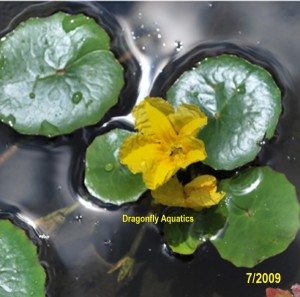 This is a picture of the floating hearts in my pond. The floating heart is a water lily like plant that looks and grows much like a water lily. The miniature size is ideal for small ponds and containers. I planted mine right in my bog area anchored at the rocks edge. It grows freely across the pond water in only a few inches of water.
This is a picture of the floating hearts in my pond. The floating heart is a water lily like plant that looks and grows much like a water lily. The miniature size is ideal for small ponds and containers. I planted mine right in my bog area anchored at the rocks edge. It grows freely across the pond water in only a few inches of water.
This is a hardy plant in Zones 5-11. It is very free-flowering and a fast grower with a running spread. It ideally grows in 4-24 inches of water. The leaves are slightly toothed and an even green, sometimes showing a hint of brown throughout the leaves. It will bloom throughout the growing season with little to no care.
You can find floating hearts here.
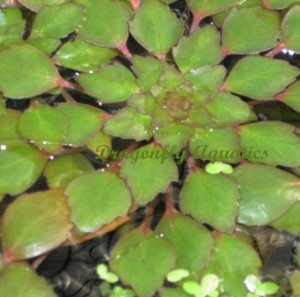 A mosaic plant is a very unique and unusually different marginal water plant that grows mostly as a submerged plant. Its leaves grow from a central radius so that the foliage forms a mosaic like circle. The leaves are green with red edges and stems. The mosaic plant is a attractive plants that quickly provides water coverage in the warm and sunny to partly shady areas of your pond. It prefers water that is not acidic or at least neutral and will die in pond water that is above a pH of 8. It grows best in 12-18 inches of warm water. Make sure your water temperatures are above 65 degrees as the mosaic plant prefers warm water. It is best to anchor the roots in dirt along your pond edge and let it grow out over your pond surface.
A mosaic plant is a very unique and unusually different marginal water plant that grows mostly as a submerged plant. Its leaves grow from a central radius so that the foliage forms a mosaic like circle. The leaves are green with red edges and stems. The mosaic plant is a attractive plants that quickly provides water coverage in the warm and sunny to partly shady areas of your pond. It prefers water that is not acidic or at least neutral and will die in pond water that is above a pH of 8. It grows best in 12-18 inches of warm water. Make sure your water temperatures are above 65 degrees as the mosaic plant prefers warm water. It is best to anchor the roots in dirt along your pond edge and let it grow out over your pond surface.
Its running spread can cover 24 inches and each rosette will spread to 4 inches. During the summer small single yellow flowers will bloom.
The mosaic plant is hardy in zones 8-11 and to winter over in cooler climates needs to be brought indoors and kept in warm water of at least 65 degrees with ample light to stretch.
Buy mosaic plant,Ludwigia sedioides here.
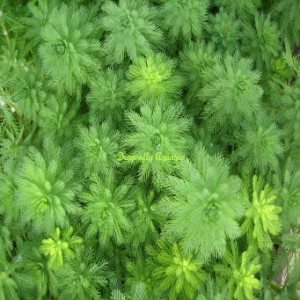 A favorite floating pond plant for all pond owners. Parrots Feather has feathery bright green foliage that floats out over the pond. The leaves may be 3 inches or more in diameter and grows on long trailing stems. It is hardy in Zones 6-11 and will grow in sun to part shade. Parrots Feather will root and form more full plants by snipping them if they get too tall. You can take the cuttings and pot them until they root, or stick the cuttings in between rocks at the waters edge, making sure the cut ends are submerged in water. The Parrots Feather will develop roots and anchor itself in the muck between the rocks. I have parrots feather in my bog that winters over year to year. And here in Ohio, we are known to have some pretty cold winters.
A favorite floating pond plant for all pond owners. Parrots Feather has feathery bright green foliage that floats out over the pond. The leaves may be 3 inches or more in diameter and grows on long trailing stems. It is hardy in Zones 6-11 and will grow in sun to part shade. Parrots Feather will root and form more full plants by snipping them if they get too tall. You can take the cuttings and pot them until they root, or stick the cuttings in between rocks at the waters edge, making sure the cut ends are submerged in water. The Parrots Feather will develop roots and anchor itself in the muck between the rocks. I have parrots feather in my bog that winters over year to year. And here in Ohio, we are known to have some pretty cold winters.
Sometimes you will see parrots feather listed as an oxygenating plant, but this variety is not commonly grown underwater.
Parrots feather grows in moist soil or up to 6 inches of water, but will float over any depth. They do great in the top of a waterfall, a bog area, stream bed or in a container water garden.
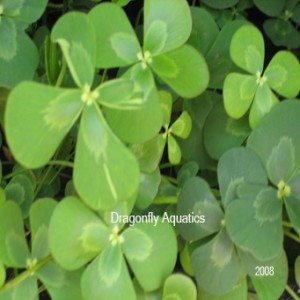 Water Clover is a lucky charm of the pond. Its delightful clover-shaped foliage floats over the ponds surface. Water clover, a popular pond plant, is grown for its attractive foliage and easy care. Grows in sun to part shade in moist soil or water to 4 inches deep. It can reach 3-6 inches high with a running spread. Zones 5-11. You can winter over by bringing indoors and keeping it as a houseplant.
Water Clover is a lucky charm of the pond. Its delightful clover-shaped foliage floats over the ponds surface. Water clover, a popular pond plant, is grown for its attractive foliage and easy care. Grows in sun to part shade in moist soil or water to 4 inches deep. It can reach 3-6 inches high with a running spread. Zones 5-11. You can winter over by bringing indoors and keeping it as a houseplant.
Buy water clover,hardy bog plant, here.